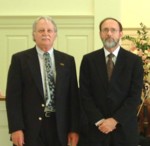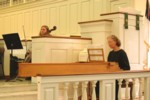The
Division of Fine and Performing Arts
of
BIRMINGHAM-SOUTHERN
COLLEGE
presents


performing
Fall
Concert

The Sanctuary
Canterbury Methodist Church
Sunday afternoon, 3:00 pm
October 21, 2001
The Red Mountain Chamber Orchestra
The Red Mountain Chamber Orchestra exists to educate and give pleasure
to the public by performing a repertoire of classical music not otherwise heard
in Birmingham, as well as to provide a musical outlet for skilled players,
conductors, and soloists, both professional and amateur, in the community.
Because of our chamber orchestra size, we are able to move about the area,
playing in different venues each season, thereby reaching a more diverse
audience and addressing ourselves more clearly to the needs and interests of
the community. Although completely independent as to policies, the RMCO has for
about a decade rehearsed and performed at Birmingham-Southern College. We are
proud to be an adjunct of BSC's Division of Fine and Performing Arts.
Founded 21 years ago, with the first concert on November 2, 1980, the
orchestra has always been based in Birmingham, although some of the players
come in from outlying communities and we perform at least once a season outside
the city.With ages ranging from 15 to 80, the most veteran of us played in the
Birmingham Civic Symphony, the youngest are students.All of us are bound
together by a passion that leads us to work on concert materials well before
rehearsals for the sake of the music. Although we include many physicians, a
dentist, a physics professor, and several band teachers, most of us studied our
instruments seriously in university music departments and at conservatories
before finding other sources of daily income.
We exist as a musical force because of the support of many who like what
we do.We would like to take this opportunity to thank those who have, over the
years, given us the tools we needed to survive and flourish:
Birmingham-Southern College, Samford University, and the Unitarian Church, all
of whom have given the orchestra a home base across the years for rehearsals
and performances; the Alabama State Council on the Arts, the Birmingham
Regional Arts Commission, and the private donors who have provided financial
support; area churches, libraries, and schools who have allowed us rehearsal
and performance space, especially the Birmingham Botanical Gardens and the
Birmingham Museum of Art;and all of the conductors, soloists, and players who
have given freely of their time and talents to work with this orchestra.
Special
thanks to the Alabama State Council on the Arts and Birmingham Regional Arts
Council for financial help with this concert. Thanks also to Rita Taufique and
Sarah Johnson for assistance at the church in planning the concert and to
Canterbury United Methodist Church for publicity, rehearsal and performance
space. As always, thanks to you our supporters, whose help makes all of these
performances possible.
Robert Wright, Conductor
Capriol
Suite for String Orchestra
Peter Warlock
Basse-Dance 1894-1930
Pavane
Tordion
Bransles
Pied-en-L'air
Mattachins
Viola
Concerto in F Major
Johann Baptist Wanhal
Allegro moderato 1739-1813
Adagio
Allegro
Michael
Kimber, Viola soloist
Symphony
#29 in A Major, K 201 W.
A. Mozart
Allegro moderato 1756-1791
Andante
Menuetto
Allegro con spirito
Our thanks to Michael
Kimber for coming from Hattiesburg, Mississippi to play the concerto.If you are
interested in checking out the books and materials he has for sale, his web
site is:
http://members.tripod.com/~m_kimber/mk.html.
Please sign our
registration book in the foyer so that we may keep you informed of future RMCO
concerts. Thanks.
Viola Concerto in F Major
Johann Baptist Wanhal, Bohemian composer, was
born in Nové-Nechanise in 1739 and died in Vienna in 1813. As a young man he
went to Vienna, had some composition lessons with Dittersdorf, and became
well-known both as a composer and as a teacher; one of his pupils was
Pleyel.After some years in Italy and Hungary, Wanhal returned to Vienna as one
of the first musicians working independently, not under the patronage system.
Wanhal was a prolific and highly regarded
composer in his day. His widespread fame is evident from an account we find in
the memoirs of an Englishman describing a quartet party he had attended in
Vienna:
"The players were tolerable, not one of them excelled
on the instrument he played, but there was a little science among them, which I
dare say will be acknowledged when I name them:
The First Violin.....Haydn
The Second
Violin.....Baron Dittersdorf
The
Violoncello.....Vanhall
The Tenor
[viola].....Mozart
A greater treat...cannot be
imagined.... After the musical feast was over, we sat down to an excellent
supper, and became joyous and lively in the extreme.
"
Wanhal's Viola Concerto in F Major is a version
of his bassoon concerto in the same key. In adapting the work for viola, Wanhal
added excellent cadenzas and rewrote the solo part to suit the technical
features of this instrument. The style is pre-Classical, earlier than Wanhal's
better-known viola concerto in C major.
Todays' performance with the RMCO is, as far
as we know, a southeastern premiere of this delightful work.
Edited by Michael Kimber
Worlock - Capriol Suite for String Orchestra
Peter Worlock was the name assumed by Philip
Heseltine, the composer of many exquisite songs and a handful of instrumental
pieces, of which the Capriol Suite is deservedly the most well known. Written
in 1926, it is based on ancient dance tunes quoted in the sixteenth century
treatise on dancing by Thoinot Arbeau. The book is written in the form of a
dialogue between the author and a lawyer called Capriol, whose name Worlock
gave to his Suite. Though first composed as a piano duet and subsequently
arranged for full orchestra, it is this string version that is performed
regularly.
The Basse Danse is
stately in character considered by Arbeau as "suitable for sage and modest
matrons", whereas the Pavane is
less solemn than usual.The Tordion is
very dainty, with a pizzicato section at the end, while the Bransles is a fast dance featuring the
tapping of one of the feet. One of Worlock's loveliest tunes is heard in Pieds-en-l'air, while by contrast there
is some harmonic dissonance in Mattachins,
a sword dance for men in armor.
Symphony No. 29 in A Major, K. 201
Mozart was just 18 when he wrote his 29th
Symphony. You'll be able to enjoy some of his stylistic treats. For one thing,
Mozart returns to the four movement symphonic form with the minuet in the third
position, as was the custom in Vienna. For another, this Symphony shows an
increased seriousness in addition the Italianate grace and charm of its
predecessors.
The first movement begins softly with a striking theme as in the
Linz Symphony, recognizable by a recurrence of a skipping octave. Horns and oboes
join strings for a repetition of the main theme. The slow movement, although
cast in the same form as the first, is entirely different in character, almost
a serenade in spirit. No longer a courtly dance, the Minuet has a vigor in the dotted rhythms and a near violence in the
sudden fortissimos that anticipate the spirit of Beethoven. The Finale is gay and energetic, with a
zestful main theme that may call to mind the first movement theme because of
the octave jumps they share.
Edited by Oliver Roosevelt
Our Soloist
Violist Michael Kimber joined the string
faculty of the School of Music at The University of Southern Mississippi in
1999 after having taught viola at The University of Kansas for twenty years.Formerly
violist of the well-known Kronos Quartet, a founding member of the Atlanta
Virtuosi, and a founding member and principal violist of the Kansas City
Chamber Orchestra, Dr. Kimber has performed in Europe, Australia, and
throughout North America.
As a viola soloist
Kimber has appeared with a number of orchestras and has been featured on
National Public Radio's "Performance Today." He has also been active
as a baroque violinist and violist. He currently serves as principal violist of
the Meridian Symphony Orchestra and returns to Kansas City annually to perform
in the Summerfest chamber music series there.Kimber’s compositions for strings
have earned widespread recognition and enjoyed performances both in the U.S.
and abroad.
Our Conductor
ROBERT WRIGHT is
Coordinator of Vocal and Choral Music at the University of Montevallo. A native
of Bessemer, he holds degrees from Samford University, the University of South
Florida, and the University of Miami.He has been a highly successful choral
director in Alabama, Florida, South Dakota, and Tennessee, and was for several
seasons the Associate Conductor of the Tech Community Symphony Orchestra in
Cookeville, TN. Dr. Wright returned in 1996 to the Birmingham area after
fourteen years as Director of Vocal Activities at Tennessee Technological
University, where his choir performed to critical acclaim at state, regional,
and national music conventions.
Dr. Wright is active as a singer and
conductor and is a member of the American Choral Directors Association and
Music Educators National Conference as well as the Alabama Music Educators
Association and Alabama Vocal Association. This is his sixth concert with the
RMCO.
Insert soloist and conductor
THE RED MOUNTAIN CHAMBER ORCHESTRA PLAYERS
|
First Violin Gwen Knowlton Concertmaster Susan Dean Godehard Oepen Kimberly
Ferguson Second Violin Dawn Grant Principal Marilyn Pipkin Katie Cruce Amanda Odom Charles Tharp |
Viola Suzanne Beaudry Principal Karen Eastman Cello Carol Leitner Principal Dorinda Smith Diedre Vaughn Daniel
Hallmark Tracy Bishoff |
Double Bass Kendall Holman Principal Oboe Lisa Buck Brian Van Tine Horn Ginny Carroll Julie McEntee Harpsichord Suzanne
Beaudry |
RMCO Administration & Board
|
PresidentSuzanne
Beaudry Vice President
Barry Jackson Recording Secretary Peggy Brooks Corresponding Secretary Gwen
Knowlton Treasurer Kendall
Holman Librarian Kimberly
Ferguson Programs David
Agresti Historian Rita
Salzberg Founder Robert
Markush |
Consultants Leslie
Fillmer, Oliver
Roosevelt Stage Managers, Web Masters Charles
Tharp Daniel
Hallmark Personnel WindsJohn
Greer StringsGodehard
Oepen Members-at-Large Linda
Mahan Heidi
Kapanka |
2001-2002- 22nd Season of the RMCO
October 21 , 3:00 pm, Fall Concert
Sanctuary, Canterbury Methodist Church
(871-4695)
Peter Warlock - Capriol Suite for strings
Mozart - Symphony #29 in A Major, K 201
Wanhal - Viola Concerto in F Major, with Michael
Kimber
Robert Wright of the University of Montevallo,
conducting
December 4 , 5:30 pm, Christmas Tree Lighting Ceremony
Linn Park, Birmingham City Center
Leroy Anderson - Sleigh Ride
Vaughn-Williams - Fantasia on Greensleeves
Neils Gade - Christmas Suite
Todd Norton of Jefferson State Community College,
conducting
February 17
, 3:00 pm, Dorsey Whittington
Concerto/Aria Competition Winners
Hill Hall, Birmingham-Southern College
The competition winners will solo with the orchestra.
Thomas Gibbs of Birmingham Southern College,
conducting
April 28
, 3:00 pm, Spring Concert
Hueytown
Methodist Church, 110 Sunset Drive, 491-3421
Corelli - Concerto Grosso
Dvorak - Legends
Howard Goldstein of Auburn University, conducting
May 12
,3:00 pm, Mother's Day Concert
Ireland Room, Birmingham Botanical Gardens
A concert of small ensemble works
June 23 ,3:00 pm, Summer Solstice
Steiner
Auditorium, Birmingham Museum of Art
A concert of small ensemble works
---As always, admission is free ---
Did you enjoy today's program?
Contributions are much needed by the Red
Mountaineers for the purchase/rental of music and other expenses. A cash
contribution would be appreciated. If you have questions, call Suzanne Beaudry
at 254-3774. We qualify as a non-profit organization under Chapter 401-C.
Please visit our web site at http://www.bham.net/rmco
~



